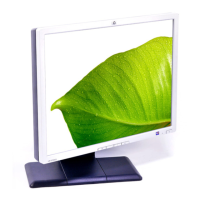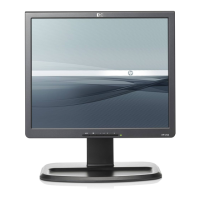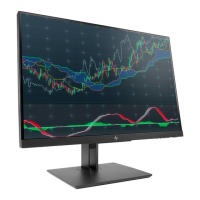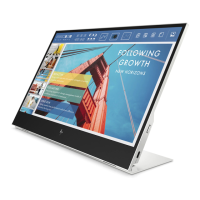
Do you have a question about the HP Invent LP2065 and is the answer not in the manual?
| Screen Size | 20 inches |
|---|---|
| Resolution | 1600 x 1200 |
| Panel Type | S-IPS |
| Brightness | 300 cd/m² |
| Contrast Ratio | 1000:1 |
| Response Time | 8 ms |
| Viewing Angles | 178° horizontal, 178° vertical |
| Aspect Ratio | 4:3 |
| Connectivity | VGA, DVI-D |
| Power Consumption | 45 W |
Essential safety precautions to avoid harm and damage to the user and equipment.
Instructions for proper care and longevity of the monitor, including usage and power.
Step-by-step guide for safely cleaning the monitor screen and body.
Guidance on how to pack and transport the monitor safely.
Steps to attach the monitor securely to its base stand for proper setup.
Identification and function of ports and switches on the monitor's back panel.
How to choose and connect video cables for optimal display signal.
Instructions for connecting the monitor to the computer and power supply.
Instructions for using the monitor's integrated USB hub with peripherals.
How to attach optional devices using the monitor's accessory rails.
Steps to detach the monitor from its base stand for alternative mounting.
Instructions for VESA mounting or using alternative fixtures like swing arms.
Where to find product identification, serial numbers, and other rating labels.
Overview of software and drivers included with the monitor for installation.
Explanation of the .INF file for ensuring OS compatibility with the monitor.
Details on the .ICM file for achieving consistent color accuracy.
Guide to installing monitor driver files from CD or HP's website.
Step-by-step instructions to install software from the provided CD-ROM.
How to obtain the latest software and drivers from HP's support website.
How to optimize image quality and screen performance using auto-adjust.
Explanation of buttons, indicators, and their functions on the monitor's front panel.
Guide to using the On-Screen Display (OSD) menu for adjusting image preferences.
Detailed explanation of OSD menu options, navigation, and functions.
Adjusting Clock and Clock Phase controls for analog input image performance.
Understanding special messages and status indicators displayed on the monitor screen.
Configuring the timer for automatic monitor power on and off cycles.
Information about the HP Display LiteSaver software for energy saving.
Steps to install and configure the HP Display LiteSaver software.
How to enable and configure sRGB for color management and accuracy.
Steps to adjust the monitor's color temperature for sRGB settings.
Guide to installing the sRGB color profile in Windows operating systems.
A table listing common issues, their possible causes, and recommended solutions.
Information on accessing HP's website for online support and resources.
Essential information to have ready when contacting technical support.
Detailed technical specifications including display size, resolution, and physical dimensions.
A list of supported display resolutions and their corresponding frequencies.
Instructions on how to save custom display settings for future use.
Information on the monitor's power saving capabilities and different power states.
FCC compliance statement for Class B digital devices and interference mitigation guidelines.
Warning about unauthorized modifications to the device and their consequences.
Requirements for using compliant shielded cables with the device for RFI/EMI control.
Guidance on the safe disposal of materials containing mercury and lead at end-of-life.
Compliance statement regarding Canadian interference-causing equipment regulations.
Compliance statement with EU Low Voltage and EMC Directives for product safety and performance.
Instructions for proper recycling of electronic waste in the EU to protect health and environment.
Guidelines for selecting appropriate power cords for the monitor based on regional voltage and current ratings.
HP's policy regarding acceptable levels of pixel defects and cosmetic imperfections.











